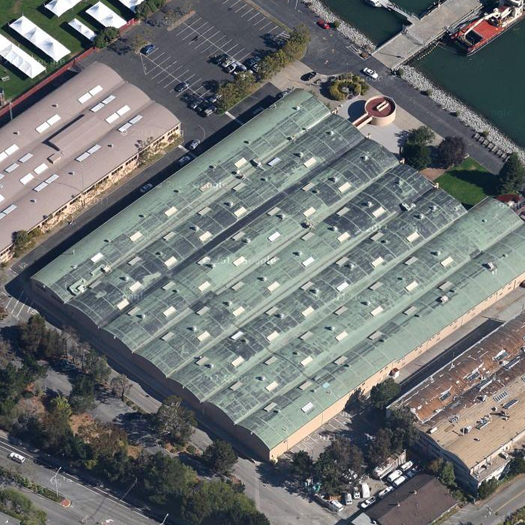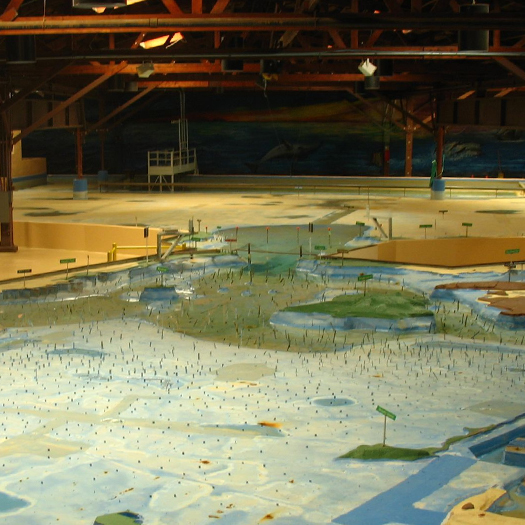

The San Francisco Bay Model was, like the Mississippi Basin Model, built by the Army Corps of Engineers to study the flow of water — in this case, simulating “the rise and fall of tide, flow, and currents of water, mixing of salt and fresh water, and… trends in sediment movement”, permitting the study of the impact of both natural events (such as floods) and human actions (such as dredging and industrial accidents). It is also, again like the Mississippi Basin Model, out of service, not having been used for active modeling since 2000, though — unlike the Mississippi Basin Model — it has found a second life as a public education center, open to guided and unguided public tours.
The San Francisco Bay Model is the only model of its size which remains intact and functional. (There were originally three comparable models built by the Army Corps, with the San Francisco and Mississippi Models joined by the Chesapeake Bay Model on Kents Island, MD. The Chesapeake Bay Model ran its last test in 1982 — successfully predicting the watery resting place of the body of the final victim of the Air Florida Flight 90 crash — and today occupies a mostly empty lot in Matapeake State Park.) Interestingly, the reason that the San Francisco Bay Model outlasted its contemporaries in active service was not only that it was indoors — the Chesapeake Bay Model was also indoors — but that “an ingenious system of 286 concrete slabs individually supported on adjustable jacks” permitted the model to be continuously reconfigured in geologic miniature to accurately represent the shifting fluid topography of the Bay area.
[The aerial image is via Google Maps; the interior shot is by flickr user chuck b.]


Maybe you’ve already addressed this in one of your posts — I’d be curious to know if there are any advantages or improved accuracy(in these days of advanced hydraulic & hydrologic computer modeling)to physical modelling over computer-based modelling? Are there any locations or situations these days where a physical hydraulic model would be better than a computer-based model?
I would be curious about this as well (but I can’t say that I’ve done the work of searching for it).
One thing that occurs to me — in the case of the final test on the Chesapeake Bay Model, it was very much a jury-rigged thing, where they suddenly decided they wanted to see if they could use the model to predict where bodies would float to, and simply found a material that would simulate the movement of a body and (literally) tossed it into the model. Maybe there’s a kind of flexibility for quickly jury-rigging new tests that is inherent in physical models, with their tolerance for fudging things? An ability to use the model for something other than its intended purpose, that isn’t easily duplicated in a computer model?
(I’m thinking something parallel to the way that hand-drawing has a tolerance for error that computer drafting, with its demand for precision, does not. In drawing, both the precision and the tolerance for error are useful, depending on the circumstance and the purpose of the drawing.)
Related to the jury-rigging idea it would seem that it requires two different skill-sets and thus one might be more useful/available to a layman of sorts (the physical model). Maybe not to interpret the results but at least to make the changes in model.
Whereas the computer model would require much more technical skills?
Might cut both ways — the physical model being easier to jury-rig as a layman, but the computer model being easier to operate for its intended purpose as a layman. (This depends, of course, on the interface of the computer model — but it seems easier to imagine an intuitive and user-friendly interface to a computer model.)
I’m surprised that the physical models you described were ever constructed at all because, even without computers and computer modelling, you would think that using calculators, hydraulic calculations and modelling techniques one could accurately estimate flows, flood elevations, velocities, etc. of a large river system.
I wonder if there are certain types of hydraulic happenings – like erosion and sediment flow — that are too complicated to accurately model with equations and calculators and which required the construction of the physical models.
Thanks for your post and reply.
I see your point that an advantage of a physical model could be that it can easily be jury-rigged, once it’s up and running.